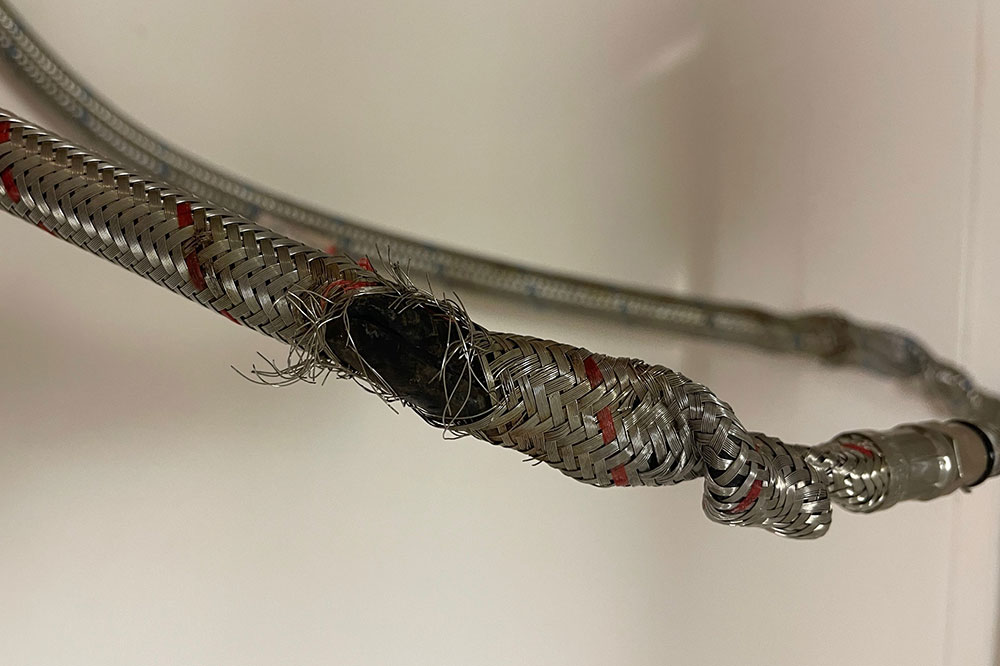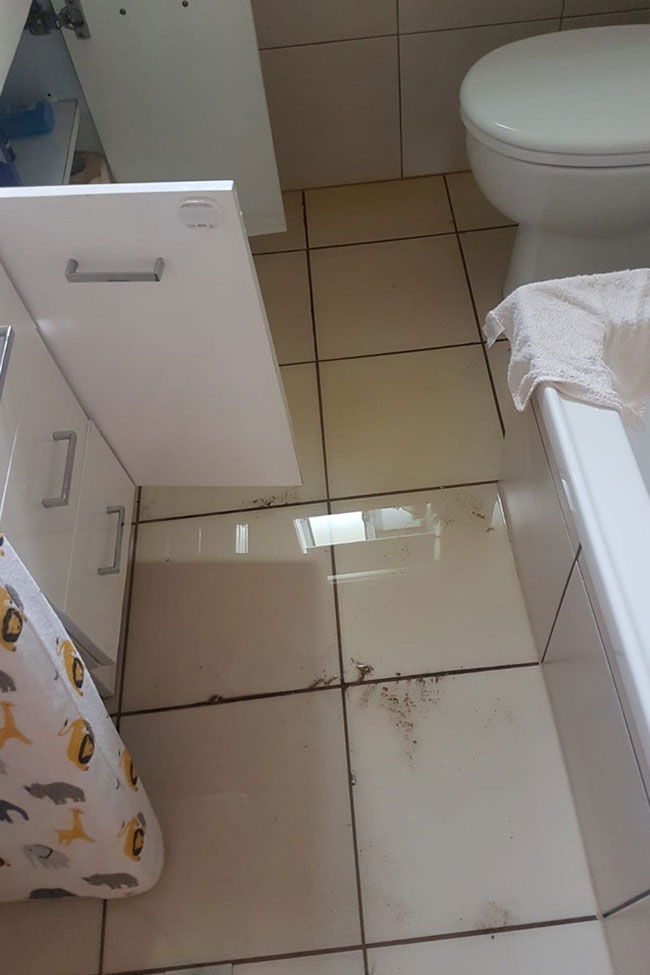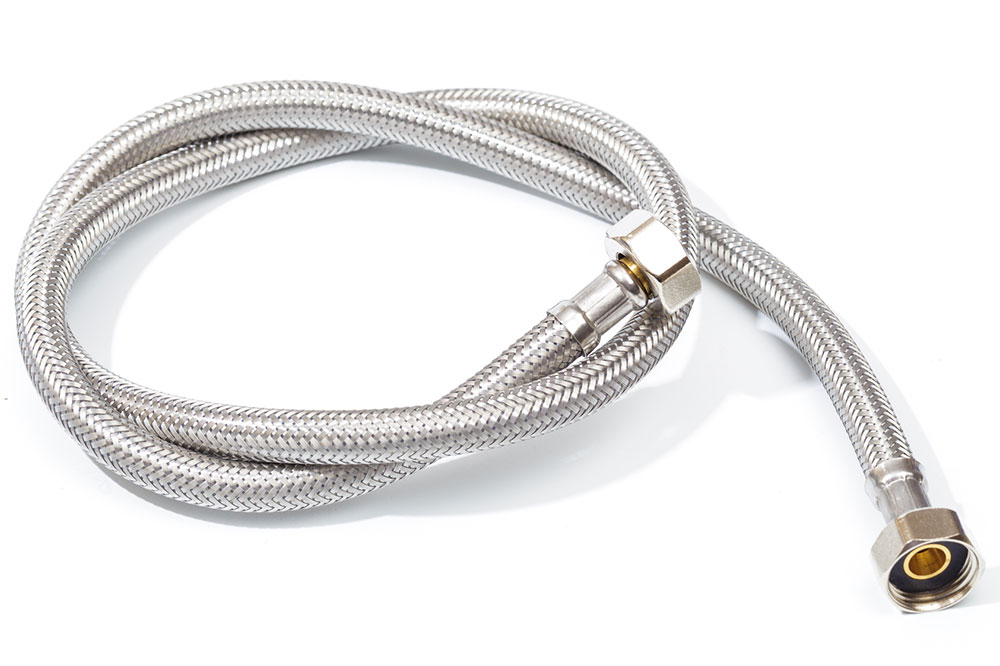Hard lesson on flexi hoses
Homeowners advised to check flexi hoses regularly to guard against costly water damage.

I’m officially a statistic – I have become one of the thousands of Queenslanders who has fallen victim to water damage at my home.
The culprit – a burst flexi hose. This is the hose under the sink that connects the taps to the water supply.
From the moment you receive a call from your neighbour telling you that you have water pouring through your floorboards, to mopping up the pooling water which has taken up residence in your bedroom, assessing damage and relocating your family (including a very active 16-month-old) to temporary accommodation, it’s certainly not an enjoyable time.
Now, I do consider myself very lucky. If it wasn’t for the diligent eyes of my neighbour, the situation could have been much worse.
But I do believe with every experience there is a lesson.

Water on the bathroom floor after a flexi hose burst.
So, what have I learnt?
I’ve learnt that flexi hoses are rubber pipes covered by braided lengths of stainless steel.
They’re cheap, widely used around the home, have a limited working life and should be checked bi-annually.
The risk of a flexi hose bursting increases dramatically around the 10-year mark.
My house, which I moved into three years ago, underwent a renovation in 2014. It is safe to say, the hose was never checked.
The damage caused can be extreme, with water flooding your house in a matter of seconds, leading to ruined cabinets, walls, floors and mould, which, in some extreme cases, can make your home uninhabitable.
While my flooding was caused by the flexi hose in the bathroom, they can also be found under kitchen sinks and in toilets, washing machines & dishwashers. Plumbed fridges are also another item for concern as the PVC tube connecting the fridge to the main water supply can also burst or separate from the joins causing flooding of the property.

A new flexi hose.
After speaking to the experts, I now know there are a few things I should do regularly:
- Look for signs of ageing: Warning signs for faulty flexi hoses include rust spots, bulging sections on the metal exterior and fraying or kinking.
- Warranty checks: Ensure all new flexi hoses come with an extended warranty period. If it’s a pre-existing hose, check for the expiry date on the collar of the hose.
- Check its surroundings: If you store chemicals under your sink, you could be putting your hose at risk of damage before the expiry date.
- Installation: If you have flexi hoses or are installing new ones, ensure they are checked and fitted by a professional plumber.
- Maintenance: Make sure to do regular checks of your flexi hoses and feel along the outer casing for any signs of damage. If you suspect a fault, contact a plumber immediately.
Hopefully my not-so-great experience will be a call to action for all home owners to check their flexi hoses regularly.
They may seem small, but they can cause a great deal of damage.
Protect your property with RACQ Home Insurance
The information in this article has been prepared for general information purposes only and is not intended as legal advice or specific advice to any particular person. Any advice contained in the document is general advice, not intended as legal advice or professional advice and does not take into account any person’s particular circumstances. Before acting on anything based on this advice you should consider its appropriateness to you, having regard to your objectives and needs.
Related topics
Things to note
The information in this article has been prepared for general information purposes only and is not intended as legal advice or specific advice to any particular person. Any advice contained in the document is general advice, not intended as legal advice or professional advice and does not take into account any person’s particular circumstances. Before acting on anything based on this advice you should consider its appropriateness to you, having regard to your objectives and needs.
Insurance Products (excluding Travel Insurance) are issued by RACQ Insurance Limited ABN 50 009 704 152 (RACQI) and arranged by its agent, RACQ Distribution Services Pty Ltd (RDS) ABN 35 116 361 650, AFSL 567130 and RDS' authorised representatives (including RACQ Operations Pty Ltd ABN 80 009 663 414, AR No. 234978 (RACQO). Conditions, limits and exclusions apply. RDS and RACQO are in the RACQ group of companies. One of the companies in the RACQ group of companies has a minority shareholding in RACQI.
RDS and RACQO have not taken your personal objectives, circumstances or needs into account when preparing advice regarding insurance products and you will need to consider whether the advice is appropriate for you. Read the Product Disclosure Statement (PDS) and any applicable Supplementary PDS before making a purchase decision on this product. You can also access our Target Market Determinations on this website. RDS receives a commission from RACQI for the policies it arranges. RACQO receives fees paid for services it provides to RDS. Further details about remuneration are available on request prior to purchasing.
Banking and loan products issued by Members Banking Group Limited ABN 83 087 651 054 AFSL/Australian credit licence 241195 trading as RACQ Bank. Terms, conditions, fees, charges and lending policies apply. This is general advice only and may not be right for you. This information does not take your personal objectives, circumstances or needs into account. Read the disclosure documents for your selected product or service, including the Financial Services Guide and the Terms and Conditions, and consider if appropriate for you before deciding.
Except for RACQ Bank, any RACQ entity referred to on this page is not an authorised deposit-taking institution for the purposes of the Banking Act 1959 (Cth). That entity’s obligations do not represent deposits or other liabilities of RACQ Bank. RACQ Bank does not guarantee or otherwise provide assurance in respect of the obligations of that entity, unless noted otherwise.
RACQ Bank subscribes to the Customer Owned Banking Code of Practice which establishes higher standards than the law requires. The Code reflects modern consumer expectations and developments in approaches to issues such as consumer vulnerability, guarantors, and supporting customers through financial hardship. Please read our Customer Owned Banking Code of Practice page for more information.
RACQ Operations Pty Ltd (ABN 80 009 663 414 AR 000234978) and Members Travel Group Pty Ltd (ABN 45 144 538 803 AR 000432492) are acting as an Authorised Representative of the issuer of the insurance, Tokio Marine & Nichido Fire Insurance Co., Ltd. (ABN 80 000 438 291 AFSL 246 548). Any advice set out above is general in nature only, and does not take into account your objectives, financial situation or needs. Before purchasing any travel products, please consider the RACQ Travel Insurance Product Disclosure Statement (PDS) and the Target Market Determinations (TMDs) that apply to these products. Whilst the PDS outlines the Terms and Conditions of these products, the TMDs outline the intended class of customers that comprise the target market for these travel products. This will allow you to consider which products best suit your objectives, financial situation and needs and consider the products appropriateness to your personal circumstances. TMDs also outline matters involving the distribution and the review of these products. The PDS, Supplementary PDS and TMDs for each travel product can be found here.
